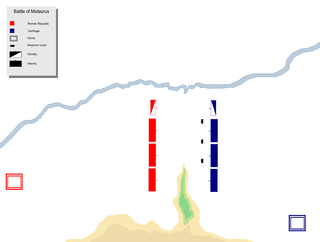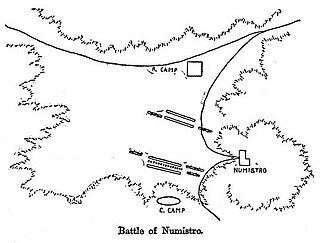
The Second Punic War was the second of three wars fought between Carthage and Rome, the two main powers of the western Mediterranean in the 3rd century BC. For 17 years the two states struggled for supremacy, primarily in Italy and Iberia, but also on the islands of Sicily and Sardinia and, towards the end of the war, in North Africa. After immense materiel and human losses on both sides, the Carthaginians were once again defeated. Macedonia, Syracuse and several Numidian kingdoms were drawn into the fighting, and Iberian and Gallic forces fought on both sides. There were three main military theatres during the war: Italy, where Hannibal defeated the Roman legions repeatedly, with occasional subsidiary campaigns in Sicily, Sardinia and Greece; Iberia, where Hasdrubal, a younger brother of Hannibal, defended the Carthaginian colonial cities with mixed success before moving into Italy; and Africa, where Rome finally won the war.
This article concerns the period 219 BC – 210 BC.
Year 212 BC was a year of the pre-Julian Roman calendar. At the time it was known as the Year of the Consulship of Flaccus and Pulcher. The denomination 212 BC for this year has been used since the early medieval period, when the Anno Domini calendar era became the prevalent method in Europe for naming years.

The Battle of Cannae was a key engagement of the Second Punic War between the Roman Republic and Carthage, fought on 2 August 216 BC near the ancient village of Cannae in Apulia, southeast Italy. The Carthaginians and their allies, led by Hannibal, surrounded and practically annihilated a larger Roman and Italian army under the consuls Lucius Aemilius Paullus and Gaius Terentius Varro. It is regarded as one of the greatest tactical feats in military history and one of the worst defeats in Roman history, and it cemented Hannibal's reputation as one of antiquity's greatest tacticians.
Gnaeus Cornelius Scipio Calvus was a Roman general and statesman during the third century BC. He played a major part in the Second Punic War, establishing Roman rule in the east of the Iberian peninsula and tying up several Carthaginian armies to keep them from reinforcing Hannibal.
The gens Fulvia, originally Foulvia, was one of the most illustrious plebeian families at ancient Rome. Members of this gens first came to prominence during the middle Republic; the first to attain the consulship was Lucius Fulvius Curvus in 322 BC. From that time, the Fulvii were active in the politics of the Roman state, and gained a reputation for excellent military leaders.

The Battle of the Metaurus was a pivotal battle in the Second Punic War between Rome and Carthage, fought in 207 BC near the Metauro River in Italy. The Carthaginians were led by Hasdrubal Barca, brother of Hannibal, who was to have brought siege equipment and reinforcements for Hannibal. The Roman armies were led by the consuls Marcus Livius, who was later nicknamed the Salinator, and Gaius Claudius Nero.
Appius Claudius Pulcher was a Roman general and politician of the 3rd century BC, active in the Second Punic War.

Gaius Claudius Nero was a Roman general active during the Second Punic War against the invading Carthaginian force, led by Hannibal Barca. During a military career that began as legate in 214 BC, he was praetor in 212 BC, propraetor in 211 BC during the siege of Capua, before being sent to Spain that same year. He became consul in 207 BC.

The second battle of Herdonia took place in 210 BC during the Second Punic War. Hannibal, leader of the Carthaginians, who had invaded Italy eight years earlier, encircled and destroyed a Roman army which was operating against his allies in Apulia. The heavy defeat increased the war's burden on Rome and, piled on previous military disasters, aggravated the relations with her exhausted Italian allies. For Hannibal the battle was a tactical success, but did not halt for long the Roman advance. Within the next three years the Romans reconquered most of the territories and cities lost at the beginning of the war and pushed the Carthaginian general to the southwestern end of the Apennine peninsula. The battle was the last Carthaginian victory of the war; all battles which followed were either inconclusive or Roman victories.

The First Battle of Capua was fought in 212 BC between Hannibal and two Roman consular armies. The Roman force was led by two consuls, Quintus Fulvius Flaccus and Appius Claudius Pulcher. The Roman force was defeated, but managed to escape. Hannibal temporarily managed to raise the siege of Capua. A tactical Carthaginian victory, it ultimately did not help the Capuans.

The Battle of the Silarus was fought in 212 BC between Hannibal's army and a Roman force led by centurion Marcus Centenius Penula. The Carthaginians were victorious, destroying the entire Roman army and killing 15,000 Roman soldiers in the process.

The Battle of Numistro was fought in 210 BC between Hannibal's army and one of the Roman consular armies led by consul Marcus Claudius Marcellus. It was the fourth time they met in a battle. Previous encounters were located around the walls of Nola (Campania) in 216, 215, and 214 and had been favourable for the Roman side.
Marcus Valerius Laevinus was a Roman consul and commander who rose to prominence during the Second Punic War and corresponding First Macedonian War. A member of the gens Valeria, an old patrician family believed to have migrated to Rome under the Sabine king T. Tatius, Laevinus played an integral role in the containment of the Macedonian threat.

The Roman Republic conquered and occupied territories in the Iberian Peninsula that were previously under the control of native Celtic, Iberian, Celtiberian and Aquitanian tribes and the Carthaginian Empire. The Carthaginian territories in the south and east of the peninsula were conquered in 206 BC during the Second Punic War. Control was gradually extended over most of the peninsula without annexations. It was completed after the end of the Roman Republic, by Augustus, the first Roman emperor, who annexed the whole of the peninsula to the Roman Empire in 19 BC.
Hanno, distinguished as the son of the suffet Bomilcar, was a Carthaginian officer in the Second Punic War.

The Battle of Beneventum was fought in 214 BC near modern Benevento during the Second Punic War. Roman legions under Tiberius Sempronius Gracchus defeated Hanno's Carthaginian forces, denying Hannibal reinforcements. Livy gives a brief description of the battle, which was part of the Roman campaign to subdue the southern Italian city-states that had joined Hannibal after the Battle of Cannae.

The Battle of Canusium also known as the Battle of Asculum was a three-day engagement between the forces of Rome and Carthage. It took place in Apulia during the spring of 209 BC, the tenth year of the Second Punic War. A larger Roman offensive, of which it was a part, aimed to subjugate and to punish cities and tribes that had abandoned the alliance with Rome after the Battle of Cannae, and to narrow the base of the Carthaginian leader, Hannibal, in southern Italy.

Hannibal's March on Rome occurred in 211 BC during the Second Punic War; the Carthaginian leader Hannibal marched by surprise with his army towards Rome, initially causing great concern among the leaders and citizens of the republic. The raid, however, ended in failure; soon, faced with firm resistance from the Romans, Hannibal left the city to head with his troops to Campania.













